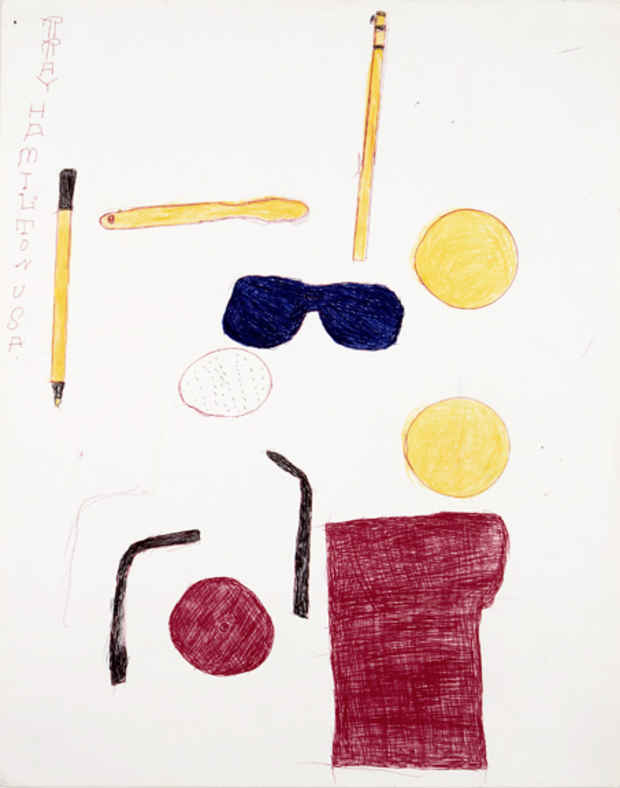"Pop" Exhibition
Kerry Schuss / K.S. Art

This event has ended.
This exhibition of drawings brings together three self-taught artists-Eddie Arning (1898-1993), Freddie Brice (1920-1998), and R.A. "Ray" Hamilton (1919-1996)-whose work shares clear affinities with Pop art. None were ever a part of the mainstream art world; nevertheless, their methodologies were startlingly postmodernist. Each utilized formal strategies that included the appropriation, abstraction, and juxtaposition; each took as their subject matter existing objects or images.
Although superficially very different from Roy Lichtenstein's early-1960s monochrome paintings of sneakers, golf balls, tires, and spools of thread, Freddie Brice's arrangements of common objects likewise feature thick black outlines, minimal color, and surface patterning. The sinuous lines and percussive stipplings in his drawings and paintings may call to mind Philip Guston, but Brice's iconic pictures of watches, rings, Pepsi bottles, and cups-lifted from spreads in glossy magazines-are pure Pop, depicting things that have undergone a transformation into products.
Hamilton's drawings, like Brice's, dispense with conventional spatial and figure-ground relationships. In some, a single image fills the page, breaking it up into a nearly abstract arrangement of geometric forms. In others, the traced shapes of plastic carry bags, bottles, glasses, keys, coins, and fruit (the outlines of each object filled in with dense crosshatchings of ink or pencil), are arranged individually or in groups, on expanses of blank paper. Reminiscent of the art of Jasper Johns, not least for their luxurious surfaces, Hamilton's works employ an extensive and interchangeable lexicon of found and remembered forms that are, as Johns described his own images, "drained of illusion, reduced to pattern."
Arning's colorful oil pastels were often derived from advertisements for liquor, cigarettes, or pharmaceuticals. Although more highly mediated, their compositional elements reduced to simple streamlined shapes, they have something in common with Andy Warhol's Newspaper Front Pages of the 1960s and Ads of the 1980s-although they feature lively, convivial people interacting in charming interiors or idyllic natural settings, they are curiously affectless themselves.
The work of all three artists reflects the same 20th-century American environment-with its commodities, architecture, printed matter, and signage-that is reflected in the paintings and drawings of Johns, Robert Rauschenberg, Ed Ruscha, Lichtenstein and Warhol. Brice's Movado Museum watches, Hamilton's near-at-hand objects, and Arning's narcotized figures, in their own way dispatches from 20th-century America, may come to us from a place well outside of contemporary art discourse, but they are no less contemporary for that.
Eddie Arning (1898 - 1993) was born in Texas to German immigrant parents. He began making art in 1964 at the age of 66, creating between 2000-2500 drawings before stopping again in 1973. His work was seen most recently in the 2010 exhibition "Approaching Abstraction" at the American Folk Art Museum, New York. Arning's drawings are in the collections of the Philadelphia Museum of Art, the Milwaukee Art Museum, the National Museum of American Art, and the Museum of American Folk Art.
Freddie Brice (1920-1998) was born in Charleston, South Carolina and moved to Harlem at age nine. He began painting in the 1980s at a senior center on Manhattan's Upper West Side Manhattan. Brice's work was featured in "Art's Mouth, " a 1991 exhibition at Artist's Space curated by Connie Butler, and is in the collections of the Philadelphia Museum of Art, the Milwaukee Museum of Art and the Old Dominion University, Gordon Collection, Norfolk, Virginia. His recent solo exhibition at KS Art in spring received reviews in the New York Times, the New Yorker and Time Out New York.
Ray Hamilton (1919-1996) was born in Anderson County, South Carolina. He served in the Navy during World War II, and after the war moved to New York City. He began to make art in the early 1980s. Hamilton's work has been featured in Raw Vision magazine as well as in American Self-Taught, by Roger Ricco and Frank Maresca (Knopf, 1993) and How to Look at Outsider Art by Lyle Rexer (Abrams, 2005).
Anne Doran is a New York based writer and editor for the visual arts. This is her first curatorial project.
Media
Schedule
from January 27, 2011 to March 12, 2011